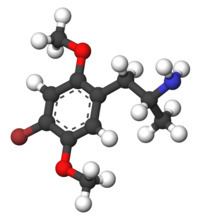Formula C11H16BrNO2 Melting point 63 °C | Molar mass 274.15 g/mol | |
 | ||
IUPAC ID 1-(4-Bromo-2,5-dimethoxyphenyl)-2-aminopropane | ||
Dimethoxybromoamphetamine (DOB), also known as brolamfetamine (INN) and bromo-DMA, is a psychedelic drug and substituted amphetamine of the phenethylamine class of compounds. DOB was first synthesized by Alexander Shulgin in 1967. Its synthesis and effects are documented in Shulgin's book PiHKAL: A Chemical Love Story.
Contents
Chemistry
The full name of the chemical is 2,5-dimethoxy-4-bromoamphetamine. DOB has a stereocenter and R-(–)-DOB is the eutomer. This is an important finding as it is suggestive that it is targeting different receptors relative to most other phenethylamines (e.g. MDMA) where the R-isomer serves as the distomer. The toxicity of DOB is not fully known, although high doses may cause serious vasoconstriction of the extremities. DOB is one of the most potent compounds in PiHKAL; while the active dose is similar to that of DOI, another psychedelic amphetamine, DOB has been shown to have a higher efficacy in triggering downstream effects mediated by 5-HT2 receptors, making it likely to be slightly more dangerous than DOI in overdose, due to greater vasoconstrictive action. Omission of the amphetamine related α-methyl leads to 2C-B, a compound that possesses a lower affinity for the 5-HT2A receptor and is a weaker receptor agonist which results in drastically reduced vasoconstriction.
Pharmacology
DOB is a 5-HT2A, 5-HT2B, and 5-HT2C receptor partial agonist. Its psychedelic effects are mediated by its agonistic properties at the 5-HT2A receptor. Due to its selectivity, DOB is often used in scientific research when studying the 5-HT2 receptor subfamily. It is an agonist of human TAAR1.
It has been suggested that DOB is a prodrug metabolized in the lungs.
Legal status
Internationally DOB is a Schedule I drug under the Convention on Psychotropic Substances.
Canada
Listed as a Schedule 1 as it is an analogue of amphetamine.
Australia
DOB is considered a Schedule 9 prohibited substance in Australia under the Poisons Standard (October 2015). A Schedule 9 substance is a substance which may be abused or misused, the manufacture, possession, sale or use of which should be prohibited by law except when required for medical or scientific research, or for analytical, teaching or training purposes with approval of Commonwealth and/or State or Territory Health Authorities.
